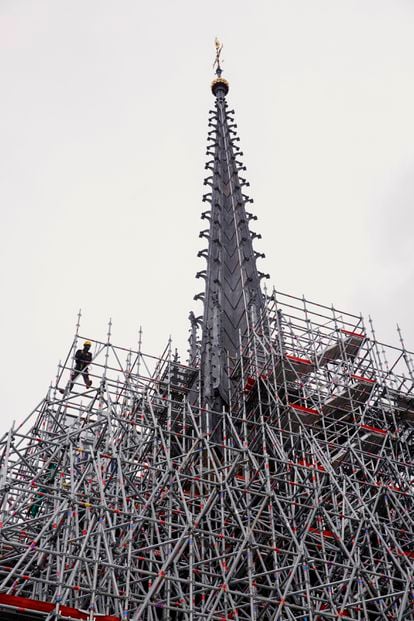On April 15, 2019, I was riding a motorcycle in Paris when a friend who was near City Hall sent me a photo with this comment: “I think Notre Dame is burning.” There was a little smoke. I accelerated and in a short time I found myself in front of the cathedral, which, indeed, was on fire. It was around 7:20 p.m. On the Tournelle bridge, from which I took the photo of people contemplating the desolate spectacle of the most visited monument in Europe engulfed in powerful flames, I felt moved and asked myself if this was accidental or a criminal act. Paris had been the victim of so many terrorist attacks…
I witnessed firsthand the collapse of the Viollet-le-Duc spire, which I filmed live. After this episode that shocked the entire world, I wanted to enter the cathedral to see the extent of the damage. I obtained authorization from the Ministry of Culture to enter for the first time at the beginning of June. There was no one inside. I remember the prevailing silence. A huge gap at the crossing of the transepts, caused by the fall of the 93-meter-high spire, allowed light to pass through. The sun cast unknown shadows on the walls. We had never seen the inside of the cathedral lit up like this, although it was when I later examined my photos that I realized it. Charred beams and stone and metal debris littered the floor. The prayer chairs of the faithful were miraculously still there, saved. None of the stained glass windows or the large organ had been affected. All valuable and fragile items had been put away. I photographed the beginning of the securing and protection phase of Notre Dame for six months. Later, thanks to a collaboration between Magnum Photos, the newly created Public Establishment for the Restoration and Reconstruction of Notre Dame, and myself, I was able to regularly document the evolution of this exceptional work.
During this first phase, the most impressive and notable was the dismantling of the existing scaffolding surrounding the Viollet-le-Duc spire, which was being restored before the fire. It was like a monster of charred, interlocking steel tubes. Scaffolders and rope workers worked every day to carefully saw through these 40,000 metal tubes without everything collapsing like a deck of cards. I got on a kind of boat to photograph them. Sometimes if the wind was too strong, the activity would stop. I had to wear a respiratory mask, a special suit, gloves and a helmet, and surround my cameras with plastic because when I left there I had to put them under water.

When the 250-ton lead needle burned, it contaminated the site, so a very strict safety protocol was quickly implemented. This fire and the incredible solidarity that followed not only allowed the cathedral to be secured and rebuilt according to the wishes of the chief architect, Philippe Villeneuve, and the president, Macron, but also the restoration of the entire monument, which was really necessary due to wear and tear. of the passage of time. I photographed the removal of the dirty stained glass windows and the removal of the 8,000 pipes from the great organ that needed to be cleaned and decontaminated. Then I documented the restoration of the heart chapels, the nave and the vaults. The restoration and reconstruction phase began in June 2021 and continues to this day. The most spectacular thing is the reconstruction of the spire, with those scaffolding that I saw ascending towards the sky; its new structure, which I photographed before it disappeared behind the cover and lead trim. A symbolically strong moment occurred in December 2023, with the installation of its last structure, the cross and the rooster that culminates at 96 meters.
Notre Dame: images of the reconstruction
The rescue of Notre Dame, an unprecedented project, will be completed when the cathedral opens to the public in December 2024.
Subscribe to continue reading
Read without limits
_
#reconstruction #Notre #Dame #fire #personal #photographic #story #Patrick #Zachmann
